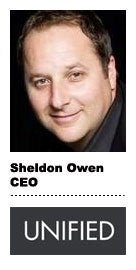How far into the social marketing story are we? Unified Social is betting this summer’s big acquisitions (Buddy Media, Vitrue, etc) are just the opening volleys, and that the coming years will see the rise of enterprise class social dashboards capable of integrating presence management, paid media, and downstream “earned” media tracking.
The company’s Social Operating Platform launched in January 2012 and has run 3,000-plus campaigns for 300 brands — some direct customers and some agencies.
AdExchanger spoke with Unified Social CEO Sheldon Owen.
What problem does Unified solve?
SHELDON OWEN: What we’re solving is the ability for big data to enhance and target advertising to the social user. We have also created within that an enterprise platform that provides full-transparency collaboration management between the brand, the agency, and the social networks directly through one central management system.
We’re all aware of the heightened M&A around social platforms, especially geared towards the enterprise. How do you view that flurry of activity that ran from late April through the middle of July, now that the smoke has cleared a bit?
What you’ve seen is the first generation of social enterprise technologies being consolidated. What I mean by first generation is, if you look at Buddy Media, Involver, Virtue, they are all primarily focused around Page management and presence management across primarily Facebook — but now cutting across other social networks. Those systems are more around content management, message management, communications into your audiences. We classify them as a first generation of social marketing platforms.
The second generation is what we see as paid solutions — people that are managing ad budgets within the social networks. Then you see a third generation, which is where we put ourselves, of “advertising operating systems.” The data, the communication, everything is starting to be centralized, and brands need to invest their dollars meaningfully into these environments, but there isn’t a true operating system that helps manage the paid investment into these networks and pulls out true measurement in ROI. That’s how we see this maturing over the years, and I think what you’ve seen in the flurry of consolidation is the first generation marketing solutions getting consolidated.
Tell me a little bit more about the product. What can it do for a marketer?
We released earlier this year what we call the Social Operating Platform. That platform is a holistic cloud-based solution that offers data management, data security, portability, and enterprise-wide privileging. Think of it as a very large data warehouse repository that allows you to store, capture, manage and index all your performance information into one platform.
From there we’ve added applications on top of that platform. Applications like planning and collaboration, enterprise workflow between agencies and brands, buying and optimization across multiple social networks so you’re not limited to just one. Then applications like “Insights” which is our measurement dashboard so you can see a consolidated view of your paid investment across the social networks into one centralized command center.
In our summer release we released our Amplet technology, which is a new application that sits on top of the social operating platform. The Amplet technology really is the first of its kind that allow for any advertiser or content producer to enable social functionality — sharing, commenting, liking — into any of the content or ads. Then we track it all back into your centralized stacks, where you can now measure and quantify the earned media result that came out of the viral effects of your ad content.
What can you say about customer adoption, growth, revenue?
I can’t disclose how many customers we have. In our stealth period we were managing a handful of customers, which were all paid partnerships. We had paying customers through 2011 to prove out the platform. Since we launched publicly this year we have doubled the size of our paying customer base. We went from 15 staff to now 36. I can’t disclose revenue numbers exactly but I can tell you that it’s in the tens of millions already. That’s run rate for 2012.
Let’s talk about real time bidding and social. Right now the only example of that is the Facebook Exchange. Do you see more of the native formats that are flourishing on different social platforms coming together with exchange-traded media at some point?
Facebook’s initiative really is kind of one-directional. They’ve opened this up for a limited group of exchange partners to retarget people at the social level. It’s not bi-directional. It’s not that you can take apart any of Facebook and bring it back out in the open web. There are some limits to what it can and cannot do.
Does this mean that exchanges are going to pop up everywhere? I think it’s too early to tell. What makes exchanges work is the fact that you’re dealing with IAB standard ad units and you can push the standard IAB suite across all the inventory. In social you’re dealing with native ad types and the ad type within Facebook is not the same ad type that’s in Twitter. Being able to bid in a mass exchange across these multiple social networks that have native ad types breeds more complexity. The non-standardization of ads is going to make it a little bit more complex than what we’re used to. It’s very early in the game to say that this is the future of social advertising.
Looking out 12 to 24 months, what do you hope to accomplish?
We will continue to release updates to our cloud-based operating platform. Those releases will happen on a quarterly basis. We use agile development and we’ve got some pretty smart machine-learning data architects within our company, and they plan to take the data sets that are generated for sharing and commenting and liking across the entire Internet — not just through Facebook — and provide intelligence to the advertiser so they can make better investment decisions in their paid media strategies.
You’ll start to also see more applications that are both built for the enterprise, that can make the agencies more efficient with social and make the brand more knowledgeable in the power of social. We look at them as partners… We don’t see cutting the agency out and only going direct.
What’s the funding picture for you? Are you eventually looking to take more investment?
We took on a good chunk of money for our Series A round. We’ve got plenty of cash to achieve what we need to. We are an operating business with a great amount of revenue on run rate as well. Will we take on more money? We’ve been asked to but at this point we haven’t. There’s not a huge need for more capital but there could be a case made that this is a great time to take on more capital because we are so far ahead of the market that we could extend that first mover advantage.
What else?
One of the things that we built on top of our Social Operating Platform was a proprietary analytics engine called our earned media framework. That framework is one of the industry-first analytic technologies that allow us to track all of this viral effect that happens inside of a social network, outside of the social network, and on the open web. You are going to see advancements on our cloud-based system around the measurement of earned media, married with TV, and you’re going to see a big push around our focus that earned media will be tracked into a more centralized system.
Follow Sheldon Owen (@JSheldonOwen) and AdExchanger (@AdExchanger) on Twitter.















